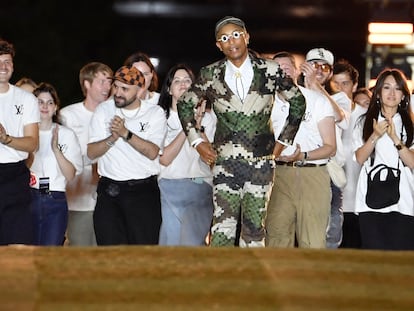Silvia Venturini Fendi: ‘For me, fashion and craftsmanship are the same’
The Italian label’s artistic director of men’s fashion is the third generation of her family to lead the brand
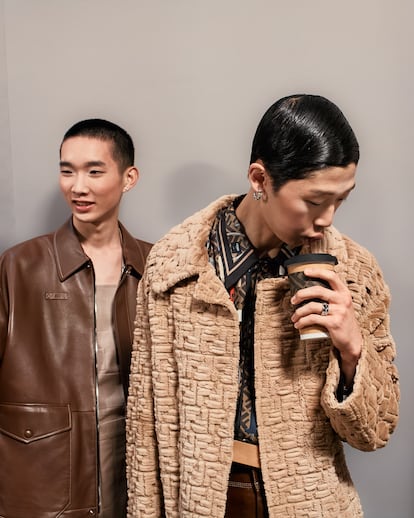
Fashion is not an acquired taste for Silvia Venturini Fendi, 62. Very few foundational European luxury fashion houses — those created before World War II — still have family members in creative positions. That’s why Venturini Fendi, the artistic director of the men’s fashion and accessories collections, has a story that one hears less often these days: she has been around the craft since birth. “As a child, when I went to see my mother at work, she was always very busy,” she recalls. “To avoid disturbing her, I would often go to the lab and hang out with the dressmakers, who would give me fabrics and let me help out with a task. The workshop was my favorite place; I had the best time there. I grew up watching my mother talk to the artisans, and it was a real fashion education. When I go into the factory, I feel at home. I could almost say that I have the heart of an artisan.”

The designer’s office in Fendi’s new accessories factory — an exquisite and ultra-technological example of contemporary architecture — has two large windows. One overlooks the landscaped garden, where carefully tended flowerbeds harmonize with the idyllic panorama of Tuscan hills. The other window leads to the workshop where the company’s bags are made. There, among artisans at work, next spring’s men’s collection fashion show is taking place. Notably, the factory isn’t located in Milan, the traditional capital of Italian fashion, or in Rome, where the brand’s historical headquarters are. But everything has a reason. “In 1910 my grandmother Adele came to Florence because she had relatives who were involved in leather goods and wanted to learn the trade, so, in a way, this is where our story began,” says Venturini Fendi, the founder’s granddaughter. Now, Fendi is returning to Tuscany because, as she explains, the world — and luxury — is returning to craftsmanship. “We live in a very virtual reality, and I think it’s time to regain contact with the material; it’s not a coincidence that so many young people have not only become interested in nature again, but [also] in working in the countryside,” she argues. “Hence the idea of representing a new youth that is interested in technology and craftsmanship. This space is a good example: here you can breathe the atmosphere of tomorrow. It’s more reminiscent of a scientific laboratory than a factory.”
The interview takes place an hour before the fashion show, which, as usual, reflects the brand’s silent luxury. The garments are not flashy and do not aspire to mass appeal, but they are recognizable on sight and are far more complex than a prohibitively expensive basic. Fendi features logos, touches of color, recognizable silhouettes and, especially, the noticeable treatment of the materials — the brand’s knitwear looks like fur (and vice versa) and its denim is worn to the exact point where the inner weave becomes visible but without threatening the fabric’s integrity. Fendi’s natural dyes come from local plants. The fashion house pays tribute to craftsmanship in the patterns with which the garments are made, as well as with the tools inserted in aprons and printed on shirts. “For me, fashion and craftsmanship are the same thing, at least in our case” she explains.
Fendi was established in 1925 as a leather goods house. It also produced fashion: starting in 1965, Karl Lagerfeld designed its fur and women’s ready-to-wear collections in what was the longest partnership of his prolific career. Silvia Venturini Fendi is the daughter of one of the five sisters who led the brand’s rise in the second half of the 20th century (her own daughter, Delfina Delettrez Fendi, is a jewelry designer). “I learned rigor and a sense of duty, coupled with great gentleness and enormous strength, from my mother,” she says. “From Karl, I learned to never look back, to always want to outdo myself.” Does she consider herself nostalgic? “No. In fact, if you talk to me about the past collection, I couldn’t tell you what it was. That’s where I’m similar to Karl, who had a huge influence on me; I was five years old when I met him!”
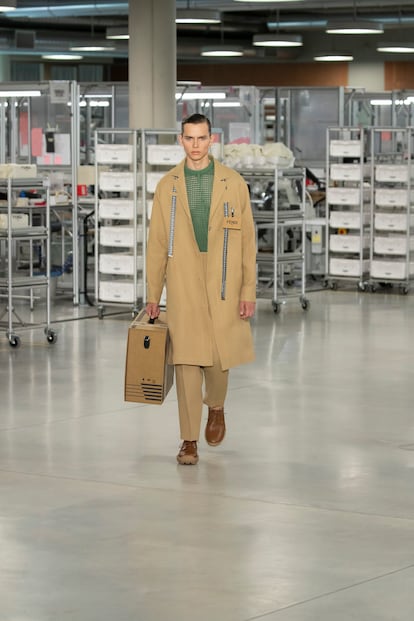
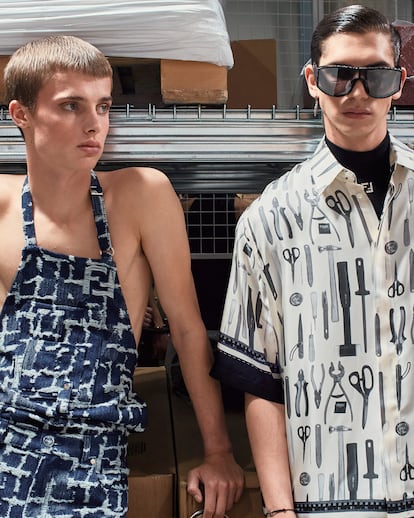
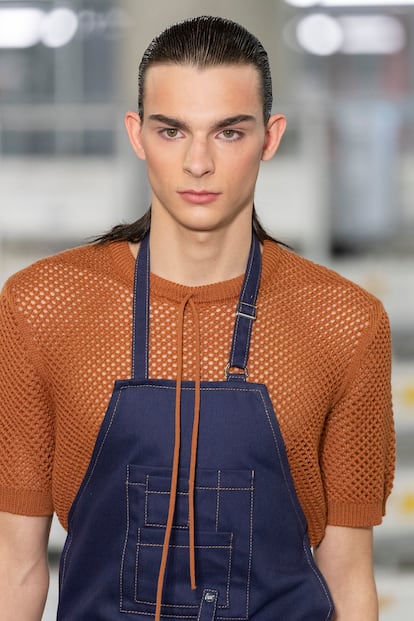

While Silvia Venturini Fendi doesn’t want to dwell on her accomplishments, she certainly could: for the record, she created the Baguette, the hugely successful bag that gave rise to the golden age of the “it bag” in the late 1990s. This small rectangular model, with a short handle that made it necessary to carry it under the arm like a loaf of bread (hence its name), made Fendi the gold standard of traditional fashion houses, especially after the company was acquired by luxury giant LVMH in 1999. That’s why it’s hard to take Venturini Fendi seriously when she claims that she was chosen to design the brand’s men’s collection by default. “Fendi had never done men’s fashion, no one gave it any importance. Karl wasn’t interested in men’s fashion, he never wanted to do it. They asked if anyone wanted to take on the collection; no one volunteered, so they gave it to me. I was up for giving it a try.” Her first collections came about intuitively. “I never had a plan, I just did what I would have liked to see a man wear,” she says. “I know Fendi well, and I know what its potential is. It’s a house that makes accessories and garments for very refined people, who appreciate distinction. It’s not a brand for fashion bulimics who will buy anything. If you wear Fendi, you wear Fendi for a long time, because you wear something of ours and it becomes a topic of conversation. People ask, ‘What are you wearing?’” Hence the semiotic games, the trompe l’oeil of materials and the cross inspirations that make the collections intriguing, especially because behind each garment there is a designer who speaks of her life. For example, this collection is full of allusions to uniforms and work clothes. “It’s autobiographical. I’ve always been around uniforms. I wore uniforms at school, the governess we had at home wore a uniform, the factory employees wore uniforms. They fascinate me.”
Since Lagerfeld’s death, Kim Jones has designed Fendi’s women’s collections. In other words, at Fendi there is a man who designs for women and a woman who designs for men. And that matters more than it might seem. “I find it interesting that men have been liberated by women designing for them. It’s the same thing that happened, years ago, with women’s fashion,” Venturini Fendi says. “In the past 10 years there has been a revolution and, fortunately, the boundaries are less marked. There is a lot more freedom.”
Sign up for our weekly newsletter to get more English-language news coverage from EL PAÍS USA Edition
Tu suscripción se está usando en otro dispositivo
¿Quieres añadir otro usuario a tu suscripción?
Si continúas leyendo en este dispositivo, no se podrá leer en el otro.
FlechaTu suscripción se está usando en otro dispositivo y solo puedes acceder a EL PAÍS desde un dispositivo a la vez.
Si quieres compartir tu cuenta, cambia tu suscripción a la modalidad Premium, así podrás añadir otro usuario. Cada uno accederá con su propia cuenta de email, lo que os permitirá personalizar vuestra experiencia en EL PAÍS.
¿Tienes una suscripción de empresa? Accede aquí para contratar más cuentas.
En el caso de no saber quién está usando tu cuenta, te recomendamos cambiar tu contraseña aquí.
Si decides continuar compartiendo tu cuenta, este mensaje se mostrará en tu dispositivo y en el de la otra persona que está usando tu cuenta de forma indefinida, afectando a tu experiencia de lectura. Puedes consultar aquí los términos y condiciones de la suscripción digital.
More information
Archived In
Últimas noticias
Trump claims peace in Ukraine is near, but Moscow suggests otherwise
A survivor’s account of the Interoceanic Train accident: ‘We were scared because of the speed on the curve’
The Interoceanic Train, the Mexican alternative to the Panama Canal
What is known about the Interoceanic Train derailment in Oaxaca
Most viewed
- Oona Chaplin: ‘I told James Cameron that I was living in a treehouse and starting a permaculture project with a friend’
- Reinhard Genzel, Nobel laureate in physics: ‘One-minute videos will never give you the truth’
- Why the price of coffee has skyrocketed: from Brazilian plantations to specialty coffee houses
- Pablo Escobar’s hippos: A serious environmental problem, 40 years on
- Chevy Chase, the beloved comedian who was a monster off camera: ‘Not everyone hated him, just the people who’ve worked with him’

